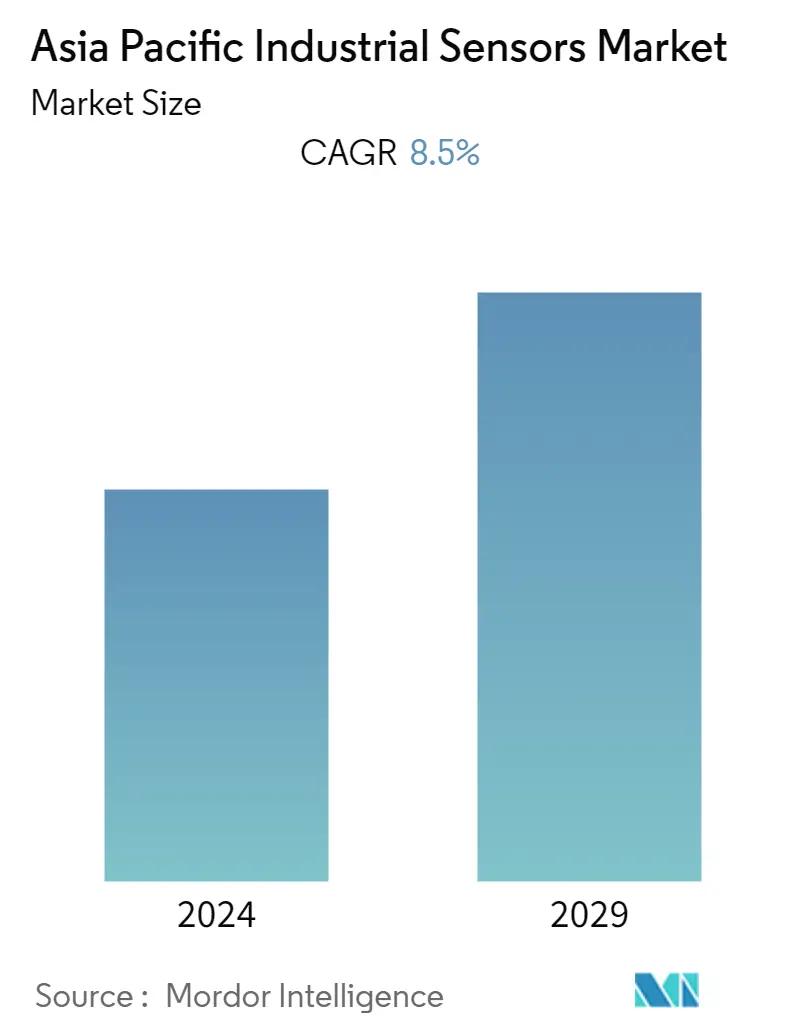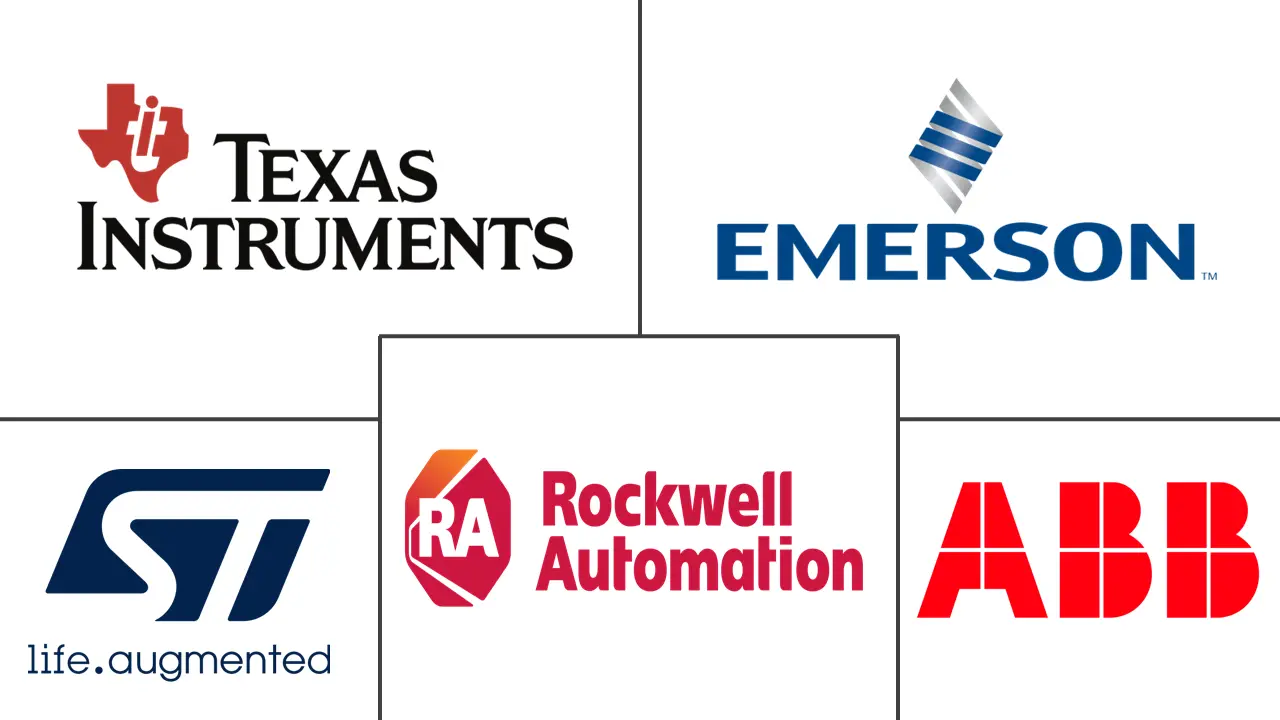Market Size of Asia Pacific Industrial Sensors Industry

| Study Period | 2019 - 2029 |
| Base Year For Estimation | 2023 |
| Forecast Data Period | 2024 - 2029 |
| Historical Data Period | 2019 - 2022 |
| CAGR | 8.50 % |
| Market Concentration | Low |
Major Players
*Disclaimer: Major Players sorted in no particular order |
APAC Industrial Sensors Market Analysis
The Asia-Pacific Industrial Sensors Market is expected to register a CAGR of 8.5% during the forecast period 2022-2027. Industrial sensors are primarily manufactured in the APAC region, and sensor technology is widely used worldwide, as most cutting-edge technologies rely on sensor functionality. Because the APAC region is experiencing the trend of smart devices and smart environments, industry 4.0, and IoT, the region's application of sensors is still evolving and increasing in comparison to developed regions such as North America. China and Japan are the key industrial sensor markets in the Asia Pacific region.
The demand for automation is increasing in government-designated critical industries such as food and beverage, manufacturing, and pharmaceutical, owing to a lack of workforce and the need for remote monitoring and working, which has fueled the demand for various sensors.
The traditional boundaries of automation and control functions in the process and manufacturing industries are being challenged by Industry 4.0. It is enabling a broader range of functions and industries through global initiatives and architectural frameworks such as Japan's Society 5.0 and Made-in-China 2025.
Smart sensors in the manufacturing industry improve device operational efficiency, effectiveness, and reliability. Various sensors, such as gas, image, and proximity sensors, in conjunction with technologies such as IoT and AI, transform manufacturing plants into connected, dependable, and cost-effective facilities. The region's expanding manufacturing sector may also drive demand for sensors to improve processing and data communication.
The prominent factors driving the growth of the industrial sensors market include an increase in Internet of Things and Industry 4.0 penetration, an increase in industrial automation, and favorable government regulations toward the use of industrial sensors. However, the high initial cost of the sensor device limits the growth of the industrial sensors market. Conversely, the increased adoption of smart sensors in a variety of industries is expected to provide potential opportunities for market expansion.
Cost, operations, and maintenance problems are some factors limiting market growth in the Asia-Pacific region. High installation costs may discourage the use of sensor technology. The sensor specification varies depending on the application, and the cost of the sensors is determined by the quality of raw materials used. For instance, selecting high-quality raw materials is crucial to producing a superior temperature sensor.
According to the National Bureau of Statistics (NBS) China registered an increase in its natural gas output in the first 11 months of 2021. The country's natural gas output totaled 186 billion cubic meters during the January-November period, growing 8.9% from a year ago and 19% from the 2019 level. The development of industries in the region is driving the demand for inductive proximity sensors, owing to their applications in the oil and gas industry.
In the midst of COVID-19, there was a strong demand for industrial sensors for efficient industrial operations, with predictive maintenance offering lucrative opportunities to market players and increasing demand from automobile manufacturers to deliver improved safety and comfort for smart sensors.
APAC Industrial Sensors Industry Segmentation
Sensors are devices that detect or measure a physical property and record, indicate, or respond to it in some other way. An industrial sensor is defined as an input device that outputs a signal in relation to a physical quantity (input). Modern plants employ a plethora of sensors, each with its own distinct design and function.
The Asia-Pacific Industrial Sensors Market is segmented by Product (Pressure, Temperature, Level, Flow, Magnetic Field, Acceleration & Yaw Rate, and Gas) and By End-User (Automotive, Aerospace & Military, Chemical & Petrochemical, Medical, Electronics & Semiconductor, Power Generation, Oil & Gas, Food & Beverage, and Water & Wastewater), and by Country.
| By Product Type | |
| Pressure | |
| Temperature | |
| Level | |
| Flow | |
| Magnetic Field | |
| Acceleration & Yaw Rate | |
| Gas | |
| Other Product Types |
| By End-user Industry | |
| Automotive | |
| Aerospace & Military | |
| Chemical & Petrochemical | |
| Medical | |
| Electronics & Semiconductor | |
| Power Generation | |
| Oil & Gas | |
| Food & Beverage | |
| Water & Wastewater | |
| Other End Users |
| By Country | |
| China | |
| Japan | |
| South Korea | |
| Rest of Asia-Pacific |
Asia Pacific Industrial Sensors Market Size Summary
The Asia-Pacific industrial sensors market is experiencing significant growth, driven by the region's rapid adoption of smart devices, Industry 4.0, and IoT technologies. This growth is further fueled by the increasing demand for automation in critical industries such as food and beverage, manufacturing, and pharmaceuticals, where remote monitoring and reduced workforce reliance are becoming essential. The region's manufacturing sector, particularly in China and Japan, is a major contributor to this demand, as smart sensors enhance operational efficiency and reliability. The integration of sensors with IoT and AI technologies is transforming manufacturing plants into connected and cost-effective facilities, supporting the broader trend of digitalization across various industrial verticals.
Despite the promising growth prospects, the market faces challenges such as high initial costs and maintenance issues, which can hinder the widespread adoption of sensor technologies. However, the increasing penetration of IoT and Industry 4.0, along with favorable government regulations, presents opportunities for market expansion. The automotive and consumer electronics sectors, particularly in China and South Korea, are key end users driving sensor demand. The region's competitive landscape is marked by the presence of major companies like Rockwell Automation, Honeywell International, and Siemens, which are actively innovating and expanding their sensor offerings to meet the evolving needs of the market.
Asia Pacific Industrial Sensors Market Size - Table of Contents
-
1. MARKET INSIGHTS
-
1.1 Market Overview
-
1.2 Industry Attractiveness - Porter's Five Forces Analysis
-
1.2.1 Threat of New Entrants
-
1.2.2 Bargaining Power of Buyers/Consumers
-
1.2.3 Bargaining Power of Suppliers
-
1.2.4 Threat of Substitute Products
-
1.2.5 Intensity of Competitive Rivalry
-
-
1.3 Industry Value Chain Analysis
-
1.4 Assessment of the COVID-19 Impact on the Market
-
-
2. MARKET SEGMENTATION
-
2.1 By Product Type
-
2.1.1 Pressure
-
2.1.2 Temperature
-
2.1.3 Level
-
2.1.4 Flow
-
2.1.5 Magnetic Field
-
2.1.6 Acceleration & Yaw Rate
-
2.1.7 Gas
-
2.1.8 Other Product Types
-
-
2.2 By End-user Industry
-
2.2.1 Automotive
-
2.2.2 Aerospace & Military
-
2.2.3 Chemical & Petrochemical
-
2.2.4 Medical
-
2.2.5 Electronics & Semiconductor
-
2.2.6 Power Generation
-
2.2.7 Oil & Gas
-
2.2.8 Food & Beverage
-
2.2.9 Water & Wastewater
-
2.2.10 Other End Users
-
-
2.3 By Country
-
2.3.1 China
-
2.3.2 Japan
-
2.3.3 South Korea
-
2.3.4 Rest of Asia-Pacific
-
-
Asia Pacific Industrial Sensors Market Size FAQs
What is the current Asia Pacific Industrial Sensors Market size?
The Asia Pacific Industrial Sensors Market is projected to register a CAGR of 8.5% during the forecast period (2024-2029)
Who are the key players in Asia Pacific Industrial Sensors Market?
Texas Instruments Incorporated, STMicroelectronics N.V., Emerson Electric Co, Rockwell Automation Inc. and ABB Limited are the major companies operating in the Asia Pacific Industrial Sensors Market.

